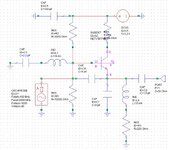ClariceStarling
Newbie

Hello,
I want to simulate a vco design with awr but I got unexpected results in the simulation.
Where do you think I'm making a mistake?
I get the spectrum output below even if I don't activate the transistor.
This is the circuit I want to simulate:

My AWR Design:

My Varactor Mode:

Transistor Model:

Spectrum Output:

I want to simulate a vco design with awr but I got unexpected results in the simulation.
Where do you think I'm making a mistake?
I get the spectrum output below even if I don't activate the transistor.
This is the circuit I want to simulate:
My AWR Design:
My Varactor Mode:
Transistor Model:
Spectrum Output:


